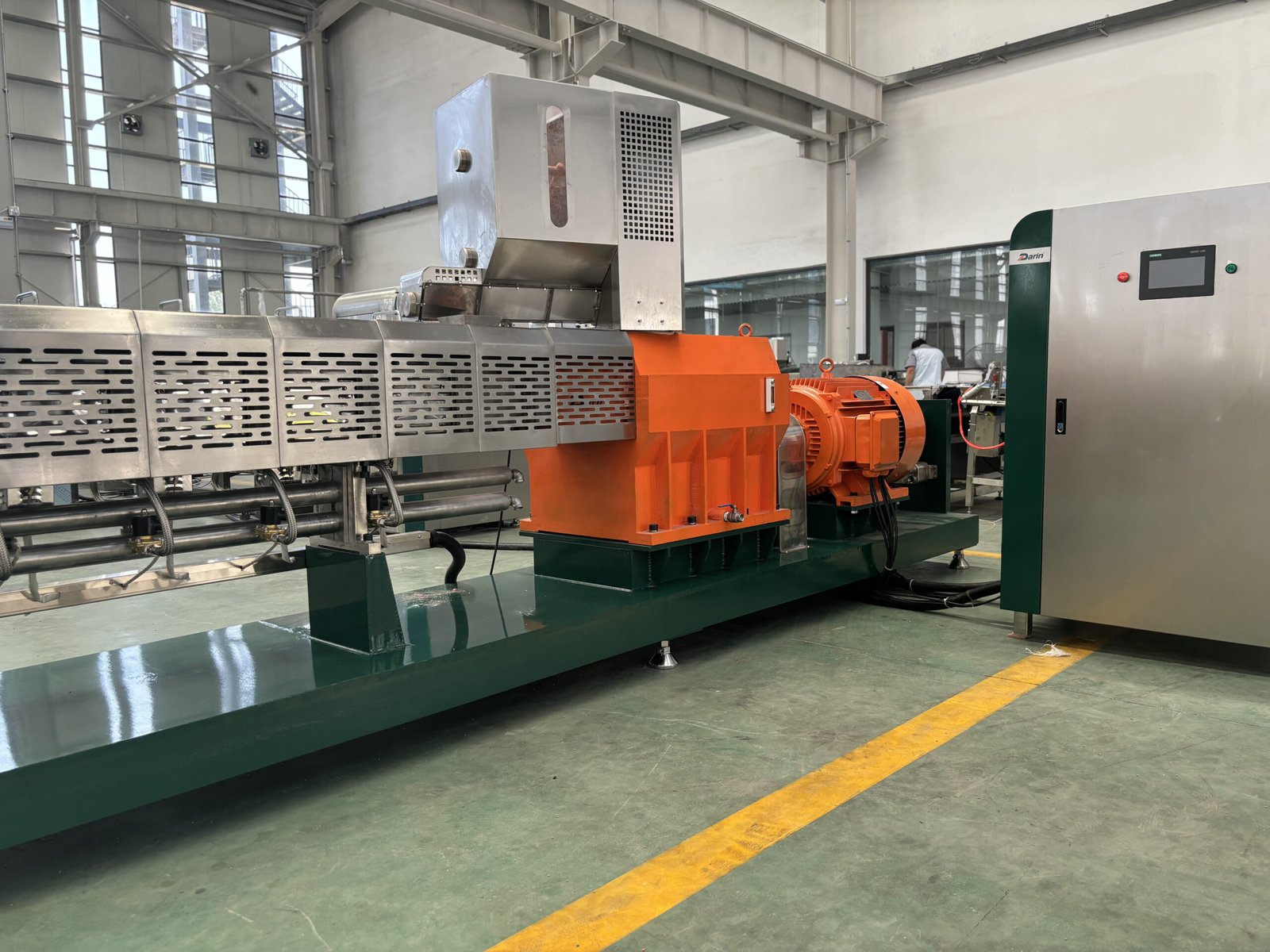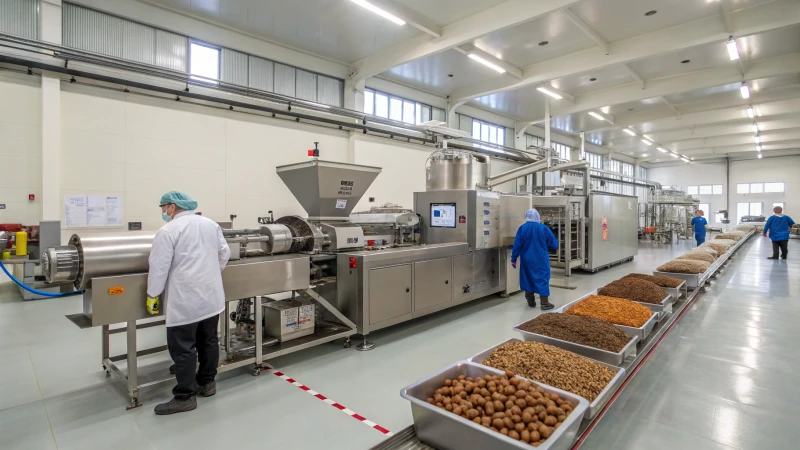
Energy consumption is a major operating cost in any pet food production facility. Many manufacturers are unaware of how significantly extrusion energy impacts overall production economics and sustainability goals. Excessive energy use not only increases utility bills but can also cause product inconsistency, mechanical wear, and environmental concerns. Choosing and optimizing the right pet food extruder requires a clear understanding of energy consumption—mechanical, thermal, and electrical. This article provides a detailed and data-driven breakdown of how much energy pet food extruders consume, what factors influence it, and how to reduce it.
On average, a pet food extruder consumes between 200 to 800 kWh per ton of finished product, depending on the formulation, extrusion type (single or twin-screw), moisture content, production throughput, and degree of automation. Energy is consumed mainly by motors (mechanical), steam or electric heaters (thermal), and support systems such as air compressors and cooling units.
Energy usage can vary widely between systems, so it's crucial to analyze your specific extrusion setup to manage operating costs effectively. In this article, we explore the types of energy used, what drives energy consumption up or down, how to monitor it, and strategies to reduce it without compromising output or quality.
Pet food extruders consume mostly electrical energy and do not require thermal energy input.Ложный
Pet food extruders use a combination of electrical energy (motors, drives, control systems) and thermal energy (typically steam or electric heating) to cook the product.
Types of Energy in Pet Food Extrusion
There are two primary forms of energy consumption in pet food extrusion:
1. Mechanical Energy (Electrical)
Used to drive:
- Screw motors
- Feed motors
- Cutting systems
- Conveyors and pumps
This is measured in kilowatts (kW) and directly correlates with:
- Product type and viscosity
- Die back pressure
- Скорость вращения и крутящий момент шнека
- System load factor
2. Thermal Energy
Used to:
- Precondition the mix (via steam or hot water)
- Cook the product inside the extruder barrel
- Dry the extruded kibble post-extrusion
Thermal energy is often generated through:
- Steam boilers (natural gas, LPG, biomass)
- Electric heaters (in compact or low-output lines)
- Gas-fired dryers or heat exchangers
Breakdown of Energy Consumption by Component
| Компонент | Energy Type | Typical Consumption (kWh/ton) |
|---|---|---|
| Screw drive motor | Electrical | 40–90 |
| Двигатель питателя | Electrical | 5–10 |
| Двигатель резака | Electrical | 3–5 |
| Прекондиционер | Steam/Thermal | 80–200 |
| Extruder barrel heaters | Steam or Electric | 30–150 |
| Сушилка | Thermal (Steam/Gas/Electric) | 100–300 |
| Cooler & Coating | Electrical + Air | 10–40 |
| Total Energy Use | Mixed | 200–800 |
Примечание: Values vary depending on whether the extruder is Одношнековый (higher thermal input, less mechanical torque) or двухшнековый (higher torque, more mechanical energy).
Energy Consumption: Single vs. Twin-Screw Extruders
| Параметр | Одношнековый экструдер | Двухшнековый экструдер |
|---|---|---|
| Torque requirement | Ниже | Выше |
| Mechanical energy | Умеренный | Высокий |
| Thermal energy input | High (more steam) | Lower (more mechanical cooking) |
| Typical energy usage | 500–800 kWh/ton | 300–600 kWh/ton |
| Product flexibility | Ограниченный | Высокий |
| Cost of operation | Higher (in steam) | Higher (in power) but better control |
Chart: Energy Contribution by Type (Example: 5 TPH Twin-Screw Line)
| Component | % Energy Consumption |
|---------------------|----------------------|
| Screw drive motor | 25% |
| Preconditioner steam| 20% |
| Dryer | 35% |
| Cooling & coating | 10% |
| Others (automation) | 10% |Factors That Influence Energy Consumption
1. Recipe Formulation
High protein or high-fiber formulations increase resistance, leading to higher torque and steam demand.
2. Target Product Moisture
Dryer products require more drying energy, significantly increasing kWh/ton.
3. Пропускная способность
Lower throughput = lower energy efficiency per ton (due to fixed energy overheads).
4. Steam Quality and Boiler Efficiency
Low-pressure or wet steam reduces thermal transfer efficiency.
5. Equipment Age and Design
Modern systems are built for energy efficiency, with insulated barrels, direct steam injection, variable frequency drives (VFDs), and efficient dryers.
Case Study: Energy Audit of a 3 TPH Line
A U.S.-based pet food facility operating a 3-ton-per-hour single-screw line showed the following energy metrics after monitoring for 30 days:
- Screw motor: Avg. 55 kWh/ton
- Steam preconditioner: 140 kWh/ton (equiv.)
- Сушилка: 220 kWh/ton
- Всего: ~415 kWh/ton
Following implementation of insulation, VFDs, and improved steam traps, the energy use was reduced to 340 kWh/ton, saving an estimated $28,000 annually.
Strategies to Reduce Energy Consumption
A. Mechanical Energy Optimization
- Используйте VFDs on motors to match real-time load
- Monitor torque vs. screw speed for optimal efficiency
- Clean screw and barrel regularly to prevent resistance buildup
B. Thermal Energy Efficiency
- Insulate steam lines, barrels, and dryers
- Use condensate recovery systems
- Optimize boiler efficiency and steam pressure
- Install moisture sensors and feedback loops in dryers
C. Automation and Monitoring
- Используйте energy meters and SCADA dashboards to identify inefficiencies
- Monitor energy per batch, per recipe, or per product line
- Adjust formulation or process settings based on energy profiles
Future Trends in Energy Efficiency
- AI Optimization: Systems learn the best settings to minimize energy per ton.
- Regenerative drying: Recover waste heat to preheat incoming air.
- Hybrid electric-steam systems: Use electric power during low-load periods to reduce boiler cycles.
- Carbon footprint monitoring: Integrated reporting for environmental compliance and ESG reporting.
Summary: Practical Guidelines
If you’re selecting or optimizing a pet food extruder, consider:
- Двухшнековые экструдеры use more electrical energy but offer lower steam demand and greater control.
- Drying is the largest thermal load, so upgrading or optimizing your dryer pays off the most.
- Energy use is product-dependent, and no single value fits all cases—monitor, analyze, and adjust.
Ready to Optimize Your Extruder Energy Efficiency?
We design and supply energy-efficient pet food extrusion systems backed by technical expertise and real-time monitoring solutions. Let us help you reduce your production costs and carbon footprint—contact our engineering team for a custom energy analysis and proposal.
ЧАСТО ЗАДАВАЕМЫЕ ВОПРОСЫ
Q1: How much energy does a pet food extruder typically consume?
A1: The energy consumption of a pet food extruder varies depending on its size, capacity, and operating conditions. Small-scale extruders may consume between 20-50 kWh, while industrial-scale extruders can require 100-500 kWh or more per hour. The total energy usage is influenced by factors such as the feed composition, moisture content, temperature, and screw configuration. Monitoring and optimizing these variables can reduce overall consumption.
Q2: What factors influence the energy usage of a pet food extruder?
A2: Several factors affect the energy consumption of a pet food extruder, including the type of raw materials used, the extruder’s design (single or twin-screw), operational parameters like temperature and pressure, and the moisture level in the feed mix. Higher protein and fat levels, lower moisture content, and longer processing times tend to increase power demands. Regular maintenance and proper calibration also play a critical role.
Q3: How can manufacturers reduce the energy consumption of pet food extruders?
A3: To reduce energy consumption, manufacturers can optimize the formulation of feed, use pre-conditioned ingredients, maintain consistent feed rates, and ensure proper maintenance of the extruder components. Implementing energy-efficient motors and drive systems, automating operations, and using real-time data for process control can also significantly enhance energy efficiency.
Q4: Is there a difference in energy efficiency between single-screw and twin-screw extruders?
A4: Yes, twin-screw extruders are generally more energy-efficient in processing complex or high-fat recipes compared to single-screw extruders. Although they may have a higher initial energy draw, twin-screw extruders offer better mixing, higher throughput, and more consistent product quality, which can reduce overall energy per unit of output over time.
Q5: Why is understanding energy consumption important in pet food production?
A5: Understanding energy consumption is crucial for cost management, environmental sustainability, and process optimization in pet food production. Reducing energy usage not only lowers operational costs but also helps meet sustainability goals and comply with environmental regulations. Analyzing energy data enables informed decisions that enhance productivity and profitability.
Ссылки
- Energy Efficiency in Extrusion Cooking – https://www.sciencedirect.com/science/article/pii/S0260877418304002 - ScienceDirect
- Energy Consumption in Twin-Screw Extrusion – https://www.researchgate.net/publication/275351856 - ResearchGate
- Pet Food Production and Energy Requirements – https://www.allaboutfeed.net/processing/extrusion/the-role-of-energy-in-extrusion/ - Все о корме
- Optimizing Extruder Performance – https://www.extru-techinc.com/extrusion-optimization - Extru-Tech Inc.
- How to Improve Energy Efficiency in Pet Food Processing – https://www.petfoodprocessing.net/articles/15167-energy-efficiency-in-pet-food-plants – Переработка кормов для домашних животных
- Understanding the Costs of Extrusion – https://www.feedstrategy.com/production/understanding-the-true-cost-of-extrusion/ - Стратегия подачи
- Двухшнековые экструдеры в сравнении с одношнековыми - https://www.thermofisher.com/blog/materials/twin-screw-vs-single-screw-extruders/ – Термо Фишер Сайентифик
- Energy Saving Tips for Extruders – https://www.ptonline.com/articles/energy-saving-tips-for-extruders – Технология пластмасс
- The Science of Extrusion in Pet Food – https://www.ncbi.nlm.nih.gov/pmc/articles/PMC6822447/ - NCBI
- Benchmarking Energy Use in Food Production – https://www.energy.gov/eere/amo/food-processing – Министерство энергетики США









